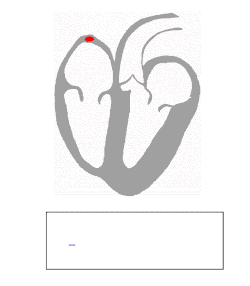ThePurkinje fibers,named forJan Evangelista Purkyně,(English:/pɜːrˈkɪndʒi/pur-KIN-jee;[1]Czech:[ˈpurkɪɲɛ];Purkinje tissueorsubendocardial branches) are located in the innerventricularwalls of theheart,[2]just beneath theendocardiumin a space called the subendocardium. The Purkinje fibers are specialized conducting fibers composed ofelectrically excitable cells.[3]They are larger thancardiomyocyteswith fewer myofibrils and manymitochondria.They conductcardiac action potentialsmore quickly and efficiently than any of the other cells in the heart'selectrical conduction system.[4]Purkinje fibers allow the heart's conduction system to createsynchronized contractionsof its ventricles, and are essential for maintaining a consistentheart rhythm.[5]
| Purkinje fibers | |
|---|---|
 Isolated heart conduction system showing Purkinje fibers | |
 TheQRS complexis the large peak. | |
| Details | |
| Identifiers | |
| Latin | rami subendocardiales |
| MeSH | D011690 |
| TA98 | A12.1.06.008 |
| TA2 | 3961 |
| FMA | 9492 |
| Anatomical terminology | |
Histology
editThis sectionneeds additional citations forverification.(November 2020) |
Purkinje fibers are a uniquecardiacend-organ. Furtherhistologicexamination reveals that these fibers are split in ventricles walls. The electrical origin of atrial Purkinje fibers arrives from thesinoatrial node.
Given no aberrant channels, the Purkinje fibers are distinctly shielded from each other bycollagenor thecardiac skeleton.
The Purkinje fibers are further specialized to rapidly conduct impulses (having numerous fastvoltage-gatedsodium channelsandmitochondria,and fewermyofibrils,than the surrounding muscle tissue). Purkinje fibers take up stain differently from the surrounding muscle cells because of having relatively fewer myofibrils than other cardiac cells. The presence of glycogen around the nucleus causes Purkinje fibers to appear, on a slide, lighter and larger than their neighbors, being arranged along the longitudinal direction (parallel to the cardiac vector). They are oftenbinucleated cells.[6]
Function
editHeart rate is governed by many influences from theautonomic nervous system.The Purkinje fibers do not have any known role in setting heart rate unless theSA nodeis compromised (when they can act aspacemakercells).[7]They are influenced byelectrical dischargefrom the sinoatrial node.
Impulse carrying
editDuring theventricular contractionportion of thecardiac cycle,the Purkinje fibers carry the contraction impulse from both the left and rightbundle branchto themyocardiumof the ventricles.[5]This causes the muscle tissue of the ventricles to contract. This generatesforceto ejectbloodout of the heart, either to thepulmonary circulationfrom the right ventricle, or to thesystemic circulationfrom the left ventricle.[8]
Replacement pacemaker
editPurkinje fibers also have the ability of firing at a rate of 20–40 beats per minute if upstream conduction or pacemaking ability is compromised.[9]In contrast, the SA node in normal state can fire at 60-100 beats per minute.[9]In short, they generateaction potentials,but at a slower rate than thesinoatrial node.[9]This capability is normally suppressed. Thus, they serve as the last resort when other pacemakers fail. When a Purkinje fiber does fire, it is called apremature ventricular contractionor PVC, or in other situations can be aventricular escape.
Etymology
editPurkinje fibers are named after theCzechscientistJan Evangelista Purkyně,who discovered them in 1839.[10]
See also
editReferences
edit- ^Jones, Daniel(2011).Roach, Peter;Setter, Jane;Esling, John(eds.).Cambridge English Pronouncing Dictionary(18th ed.). Cambridge University Press.ISBN978-0-521-15255-6.
- ^Feher, Joseph (January 1, 2012), Feher, Joseph (ed.),"5.5 – The Cardiac Action Potential",Quantitative Human Physiology,Boston: Academic Press, pp. 458–466,doi:10.1016/b978-0-12-382163-8.00049-9,ISBN978-0-12-382163-8,retrievedNovember 13,2020
- ^Stocum, David L. (January 1, 2012), Stocum, David L. (ed.),"Chapter 7 – Regeneration of Cardiac Muscle and Hematopoietic Tissues",Regenerative Biology and Medicine (Second Edition),San Diego: Academic Press, pp. 161–182,doi:10.1016/b978-0-12-384860-4.00007-1,ISBN978-0-12-384860-4,retrievedNovember 13,2020
- ^"Purkinje fiber." The American Heritage® Medical Dictionary. 2007. Houghton Mifflin Company 23 Oct. 2016http://medical-dictionary.thefreedictionary /Purkinje+fiber
- ^abBrooker, Graham (January 1, 2019), Segil, Jacob (ed.),"Chapter Fourteen – Pacemakers",Handbook of Biomechatronics,Academic Press, pp. 567–589,doi:10.1016/b978-0-12-812539-7.00014-3,ISBN978-0-12-812539-7,S2CID239396730,retrievedNovember 13,2020
- ^Paxton, Steve; Peckham, Michelle; Knibbs, Adele (2003)."histology of purkinje fibres".
- ^Christenson, Jeff (January 1, 2019), Segil, Jacob (ed.),"Chapter Three – Sensors and Transducers",Handbook of Biomechatronics,Academic Press, pp. 61–93,doi:10.1016/b978-0-12-812539-7.00003-9,ISBN978-0-12-812539-7,S2CID117312416,retrievedNovember 13,2020
- ^Podrid, Philip J.; Kowey, Peter R. (2010).Cardiac Arrhythmia, Mechanism, Diagnosis and Management.
- ^abcBaura, Gail D. (January 1, 2012), Baura, Gail D. (ed.),"Chapter 2 – Electrocardiographs",Medical Device Technologies,Oxford: Academic Press, pp. 39–57,doi:10.1016/b978-0-12-374976-5.00002-5,ISBN978-0-12-374976-5,retrievedNovember 13,2020
- ^"Jan Evangelista Purkinje | Czech physiologist | Britannica".Britannica.RetrievedJanuary 16,2021.
External links
edit- Anatomy photo: Circulatory/heart/purkinje/purkinje1- Comparative Organology at University of California, Davis – "Mammal heart, purkinje fibers (LM, Medium)"
- Anatomy Atlases – Microscopic Anatomy, plate 05.78
- MedEd at LoyolaHisto/practical/cardio/hp8-21.html
- Human Cardiac Muscle,histology slides at UC San Diego
- Cardiac Muscle Tissue with Purkinje Fibers,Lonestar College North Harris Biology